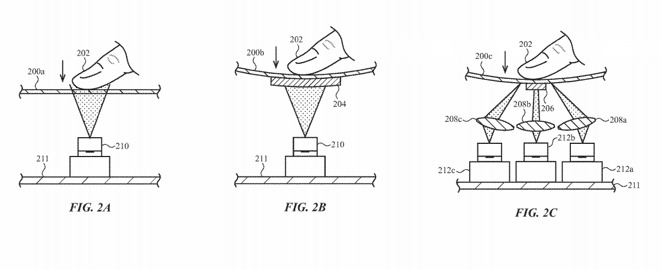Apple could use its Face ID laser tech to revolutionize iOS keyboards

What you need to know
- An Apple patent published today has revealed how the laser tech behind Face ID could revolutionize iOS typing.
- The patent shows how lasers could monitor a display for touch inputs.
- It would increase the accuracy of iOS keyboards, and could even allow for touch-typing.
An Apple patent published today has revealed how the laser technology at the heart of Face ID could also be used to track touch inputs on a display so as to revolutionize typing on a touch-screen display.

As reported by AppleInsider, the patent is titled "Self-Mixing Interference Based Sensors for Characterizing Touch Input", and is focused around VCSEL (vertical-cabity surface-emitting lasers). These lasers could be housed in a display. By emmitting light, they could measure a display surface to track touch inputs, improving the accuracy of what's recorded. According to the report:
Each VCSEL emits a beam of "coherent light" towards the surface being monitored, which is reflected and mixed in with other coherent light beams at a variety of angles into other sensors. The number of angles is important, as the deflection of the display surface can alter the angle of reflection, which means the reception of specific light beams by other sensors can inform the system of how much deflection there is.The system can be improved further still, by performing spectrum analysis on measured detections of multiple sensors to determine a speed of movement and the direction of movement. This can include reading multiple harmonic frequencies at different stages, which can also infer movement.
By measuring deflection, the system could determine not only where you are pressing, but how much pressure is being applied, similar to 3D touch. As AppleInsider notes, this feature could be engineered to ignore touches below a certain level of pressure. This could mean that a user might be able to rest their fingers on the touch screen without triggering an input, to allow for touch-typing.
Of course, filing a patent doesn't guarantee that this tech will ever feature in an iOS device of the future. However, this patent certainly is among the less outlandish and more applicable patents we've seen.
iMore offers spot-on advice and guidance from our team of experts, with decades of Apple device experience to lean on. Learn more with iMore!

Stephen Warwick has written about Apple for five years at iMore and previously elsewhere. He covers all of iMore's latest breaking news regarding all of Apple's products and services, both hardware and software. Stephen has interviewed industry experts in a range of fields including finance, litigation, security, and more. He also specializes in curating and reviewing audio hardware and has experience beyond journalism in sound engineering, production, and design.
Before becoming a writer Stephen studied Ancient History at University and also worked at Apple for more than two years. Stephen is also a host on the iMore show, a weekly podcast recorded live that discusses the latest in breaking Apple news, as well as featuring fun trivia about all things Apple. Follow him on Twitter @stephenwarwick9
